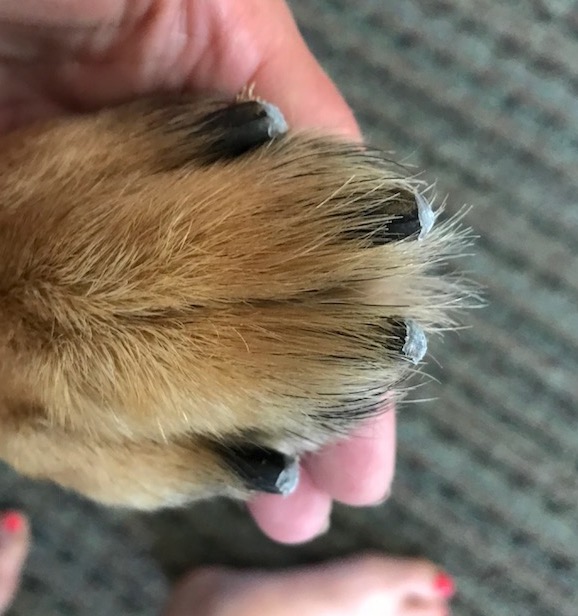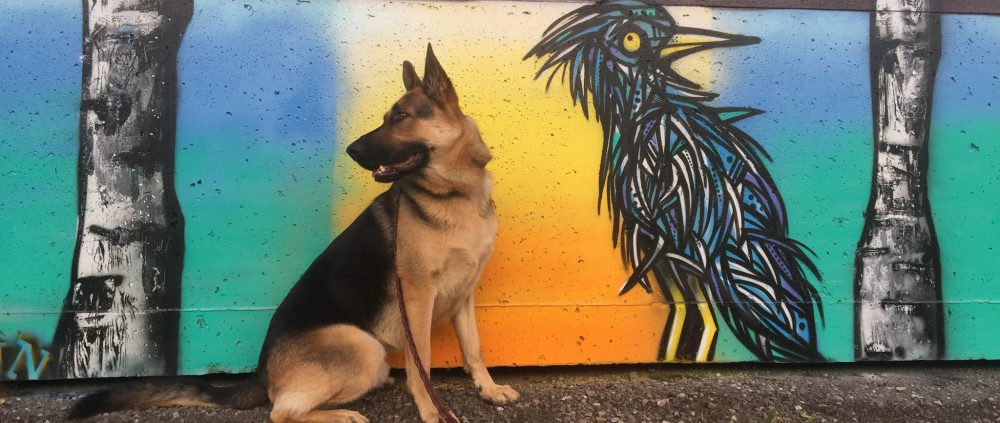Note: This is the first half of a two-part post.
Then.
The damn snow was dragging at my feet, and I knew I wasn’t going to make it to my car before I started to cry. Milo and I were not at our finest on that winter day more than three years ago. Fifteen dog-handler teams had arranged themselves in a big circle on a snowy country field, and we were taking turns walking our dogs around the group. The idea was to keep your dog paying attention to you, and not to the other dogs or people or bunnies in attendance. The accomplished teams heeled with quiet precision around the field. But most of us newbies kept our dog’s focus with a steady stream of happy chatter. We could have used food treats for this, but it is hard to hand out treats when wearing mittens and it was cold enough that mittens were mandatory.
Milo and I were doing fine until another male gave him a glance that asked: “Wanna dance?” Milo looked back: “Sure, let’s go.” And off came the gloves. The other dog snarled. Milo lunged. My feet broke through the crust on the snow, and I was stuck.
It all took a very long heartbeat. Friends swooped in to take care of Milo, and I clambered out of my hole. Everything was OK, except for my blood pressure and my pride. This was life with a reactive dog. It just took a wrong look. He didn’t fight. I saw to it that Milo never got into a fight. But both of us were bundles of stress.
Milo and I retreated to an adjacent field where we could cool down. We played a bit, did some obedience, and practised calmly watching those other dogs from a distance. I’d been working on Milo’s reactivity for a while already, but this exercise was a bit too much and a bit too soon.
What put me in tears that afternoon wasn’t just Milo’s reaction, it was the supportive kindness of the people around us. We were training with the Kitchener-Waterloo German Shepherd Club. These people know GSDs, and many of them went through similar challenges with their pups.
After a few minutes on our own, the club president came over to check on Milo and me.
“We’re going to work on recalls now, do you and Milo want to join us?”
“Really? Seriously?”
“Sure, we’re all paying attention. It will be fine.”
It was more than fine. Milo was perfect. I left him with another handler at one end of the field, ran about 30 metres away, and called him. They released him, and he was in flight, skidding into a beautiful sit in front of me. Folks cheered.
As we were packing up for the afternoon, one by one, people came up to me. They said things like:
- “It gets better.”
- “He’s a beautiful dog.”
- “I’ve been there, and I know it’s hard.”
- “Good for you for working so hard with him.”
- “Half a dozen dogs here used to react like that, and look at them now.”
I needed this support and encouragement, but darn it, I was at the end of my rope, and I knew this kindness was going to make me cry. I just wanted to get to my car before I lost it.
 I was in an all-positive obedience class at the time, and someone there asked me if Milo was abused as a pup. That question took the wind right out of my sails. I adopted him at eight weeks, and his ‘abuse’ was patience, loving-kindness, and outrageously expensive grain-free food.
I was in an all-positive obedience class at the time, and someone there asked me if Milo was abused as a pup. That question took the wind right out of my sails. I adopted him at eight weeks, and his ‘abuse’ was patience, loving-kindness, and outrageously expensive grain-free food.
When Milo and I went on walks, I took to telling people that I was rehabilitating him. The phrase turned many frowns to smiles. After all, rehabilitating rescue dogs was god’s work. It was not a lie. I was rehabilitating him. I didn’t tell them he was a rescue; I just didn’t tell them he wasn’t.
Milo and I worked hard to get his reactivity under control. We went on weekly pack walks with the German Shepherd Club, I learned about counter-conditioning and desensitisation, and I worked on keeping control of my own emotions. I had to be calm to help him be calm–this it turned out, was the most difficult part of the whole procedure. I started working on obedience and scent detection with him. These sports taught him self-control and were something positive, fun that we could excel at together. Both of our confidence soared. He is a smart and biddable dog and was always a joy to work with, in isolation.
Things were slowly getting better, but they weren’t where I needed them to be until a fellow German Shepherd Club member and friend recommended that I take Milo to the trainer who helped her reactive dog. Finally, I found a trainer who understood Milo. It sounds simple, but she taught me not to permit Milo to be, what I have come to call, a jackass. We didn’t do anything dramatic or mean; I just learned to hold him to a set of high standards and how to properly handle such a big, strong, and strong-willed dog.
This whole process took about two years. Milo is a different dog now, but sometimes I forget how far we’ve come.

Click here for the rest of our story and to see where we are at now.
 One of my spring training goals was to condition Milo to like, or at least more stoically endure nail trims. He always let me take care of his nails, but he hated it, and a mani-pedi left both of us severely stressed.
One of my spring training goals was to condition Milo to like, or at least more stoically endure nail trims. He always let me take care of his nails, but he hated it, and a mani-pedi left both of us severely stressed.

 The gift of your undivided attention is one of the simplest, although not one of the easiest, ways to show that someone you care about them. We’ve all had those conversations, sometimes serious, sometimes playful, during which we’re 100% engaged with another person. These conversations build relationships. Two people become one. Time stops. Or flies. Attention can be an expression of respect and an expression of love.
The gift of your undivided attention is one of the simplest, although not one of the easiest, ways to show that someone you care about them. We’ve all had those conversations, sometimes serious, sometimes playful, during which we’re 100% engaged with another person. These conversations build relationships. Two people become one. Time stops. Or flies. Attention can be an expression of respect and an expression of love. Milo’s puppy kindergarten graduation photo
Milo’s puppy kindergarten graduation photo
 I was in an all-positive obedience class at the time, and someone there asked me if Milo was abused as a pup. That question took the wind right out of my sails. I adopted him at eight weeks, and his ‘abuse’ was patience, loving-kindness, and outrageously expensive grain-free food.
I was in an all-positive obedience class at the time, and someone there asked me if Milo was abused as a pup. That question took the wind right out of my sails. I adopted him at eight weeks, and his ‘abuse’ was patience, loving-kindness, and outrageously expensive grain-free food.